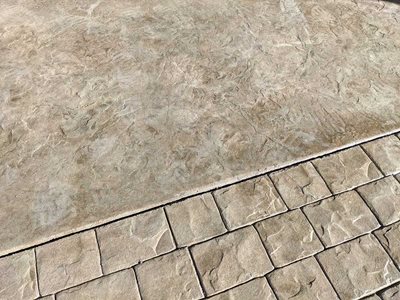
Choosing the best penetrating concrete sealer comes down to the details of the application. Sealers have different characteristics that make them better suited for specific uses. Understanding the needs of an application can help you select the flatwork, exposed aggregate, concrete overlay, or stamped concrete sealant that is best for the job.
A penetrating sealer is one that chemically bonds with the concrete instead of forming a film on the surface. These can be categorized as silicates, silanes, siloxanes, siliconates, and fluorinated sealers. Silicates are often considered densifiers or hardeners because the silica reacts in the concrete to form a more dense surface. Silanes, siloxanes, and siliconates are most commonly used as colored and stamped concrete sealers. Each of these penetrating sealers are made of extremely small molecules that penetrate deep into the concrete, stone, or masonry to provide some degree of protection and water resistance. Their impact on appearance is minimal.
The best penetrating concrete sealer uses are exterior surfaces where a matte or natural appearance is desired. Penetrating sealers will protect against moisture penetration and some contaminants. They will not enhance color or add any degree of sheen or gloss. One such ideal case would be a pool deck in a freeze-thaw climate, using a natural-looking texture like stone. The penetrating sealer would protect the concrete from chlorides and de-icing salts. It would also resist moisture penetration while remaining breathable, reducing the effects of freeze-thaw. Finally, the no-build nature of the sealer would reduce traction loss and maintain a natural look.
Even the best penetrating concrete sealer has limitations. Most notably, penetrating sealers do not enhance color. They do not add gloss or sheen, either. In many decorative concrete applications, a "wet look" is desirable. For something like that, a traditional acrylic sealer is the best bet. Penetrating sealers do not protect against abrasion or aggressive contamination. Polyurethanes and epoxies are more suitable for these high-demand environments. Finally, most penetrating sealers are not suitable for fresh concrete seal and cure. For these instances, use a concrete cure and seal. An exception is Brickform Stealth-Seal WB which can be applied as soon as bleed water has dissipated.
As with any sealer, surface preparation is key when using a penetrating sealer. Installers must make sure the concrete is clean and ready to accept the sealer before application. You must remove concrete sealer if the surface has previously been sealed. Use an appropriate chemical stripper such as Brickform Strip-It or mechanical stripping methods like media blasting. Use a cleaning and etching system, such as Brickform E-Etch and Neutra Clean to clean the concrete and open its pores. More tightly finished or densified concrete may require stronger etching for a penetrating sealer.
Even the best penetrating concrete sealer can't be used in all applications. Sometimes there are things they just can't do. Luckily, there are other Brickform sealers available for most of these applications. For example, penetrating sealers are "natural look" with minimal, if any, color enhancement or gloss. For a more traditional stamped concrete looks, solvent and water-based film forming sealers will usually do the trick. Penetrating sealers are also not ideally suited for interior concrete flooring. Performance sealers or coatings, such as Brickform Poly-Astic®, UreMax, and DecoPoxy are often the best choice here.
Properly chosen and applied, a penetrating concrete sealer is a great way to protect concrete without affecting the appearance. This is desirable in many application, including "natural look" finishes and minimalist designs.
Explore impressive concrete installations to find inspiration for your next project.
Find out how much color and fiber you'll need for any size project.